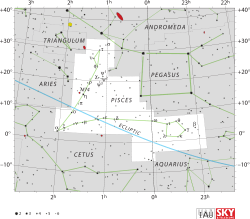Phi Piscium

Location of φ Piscium(circled) | |
| Observation data Epoch J2000.0 Equinox J2000.0 | |
|---|---|
| Constellation | Pisces |
| Right ascension | 01h 13m 44.9471s |
| Declination | +24° 35' 01.367" |
| Apparent magnitude (V) | 4.676 (A)/9.11 (B) |
| Characteristics | |
| Spectral type | K0III (A)/K0 (B) |
| U−B color index | +0.84 (A)/+0.25 (B) |
| B−V color index | +1.03 (A)/+0.92 (B) |
| Astrometry | |
| Radial velocity (Rv) | 5.9 km/s |
| Proper motion (μ) | RA: 18.58 mas/yr Dec.: -21.26 mas/yr |
| Parallax (π) | 8.64 ± 0.81 mas |
| Distance | 380 ± 40 ly (120 ± 10 pc) |
| Orbit[3], p. 160 | |
| Companion | φ Psc B |
| Period (P) | 7473 ± 3 days yr |
| Eccentricity (e) | 0.815 ± 0.005 |
| Argument of periastron (ω) (secondary) | 71.9 ± 1.7° |
| Other designations | |
Phi Piscium (Phi Psc, φ Piscium, φ Psc) is a binary star system approximately 380 light years away in the constellation Pisces. It consists of Phi Piscium A, with a spectral type of K0III, and Phi Piscium B.[1] Phi Piscium A possesses a surface temperature of 3,500 to 5,000 kelvins. Some suggest the only visible companion in the Phi Piscium B sub-system is a late F dwarf star, while others suggest it is a K0 star. The invisible component of the Phi Piscium B sub-system is proposed to have a spectral type of M2V.[4] The star system has a period of about 20½ years and has a notably high eccentricity of 0.815.[3]
Naming
In Chinese, 奎宿 (Kuí Sù), meaning Legs (asterism), refers to an asterism consisting of refers to an asterism consisting of φ Piscium, η Andromedae, 65 Piscium, ζ Andromedae, ε Andromedae, δ Andromedae, π Andromedae, ν Andromedae, μ Andromedae, β Andromedae, σ Piscium, τ Piscium, 91 Piscium, υ Piscium, χ Piscium and ψ¹ Piscium. Consequently, φ Piscium itself is known as 奎宿十四 (Kuí Sù shí sì, English: the Fourteenth Star of Legs.)[5]
References
- ↑ 1.0 1.1 "Simbad Query Result". Simbad. Retrieved October 1, 2007.
- ↑ "Simbad Query Result". Simbad. Retrieved October 1, 2007.
- ↑ 3.0 3.1 R.F. Griffin, G.H. Herbig; Herbig (1991). "Spectroscopic binary orbits from photoelectric radial velocities. Paper 99: Phi PISCIUM". The Observatory 111: 155–162. Bibcode:1991Obs...111..155G.
- ↑ R.F. Griffin, G.H. Herbig (1991). "Spectroscopic binary orbits from photoelectric radial velocities. Paper 100: Phi PISCIUM B". The Observatory 111: 201–219. Bibcode:1991Obs...111..201G.
- ↑ (Chinese) AEEA (Activities of Exhibition and Education in Astronomy) 天文教育資訊網 2006 年 5 月 19 日
| ||||||||||||||||||||||||||